Short Term Effects of Revegetation on Labile Carbon and Available Nutrients of Sodic Soils in Northeast China
Abstract
:1. Introduction
2. Materials and Methods
2.1. Study Area
2.2. Experimental Design
2.3. Soil Sampling and Analysis
2.4. Statistical Analysis
3. Results
3.1. Changes in Soil pH and EC
3.2. Changes in LOC, AN, AP, and AK Content
3.3. Changes in SR, GMSN, and SSAN
4. Discussion
5. Conclusions
Author Contributions
Funding
Conflicts of Interest
References
- Sardans, J.; Bartrons, M.; Margalef, O.; Gargallo-Garriga, A.; Janssens, I.A.; Ciais, P.; Obersteiner, M.; Sigurdsson, B.D.; Chen, H.Y.H.; Penuelas, J. Plant invasion is associated with higher plant-soil nutrient concentrations in nutrient-poor environments. Glob. Chang. Biol. 2017, 23, 1282–1291. [Google Scholar] [CrossRef] [PubMed]
- Yu, P.J.; Liu, S.W.; Xu, Q.; Fan, G.H.; Huang, Y.X.; Zhou, D.W. Response of soil nutrients and stoichiometric ratios to short-term land use conversions in a salt-affected region, northeastern China. Ecol. Eng. 2019, 129, 22–28. [Google Scholar] [CrossRef]
- Gomes, L.; Simoes, S.J.C.; Nora, E.L.D.; Sousa-Neto, E.R.; Forti, M.C.; Ometto, J.P.H.B. Agricultural expansion in the Brazilian Cerrado: Increased soil and nutrient losses and decreased agricultural productivity. Land 2019, 8, 12. [Google Scholar] [CrossRef] [Green Version]
- Craft, C.; Vymazal, J.; Kropfelova, L. Carbon sequestration and nutrient accumulation in floodplain and depressional wetlands. Ecol. Eng. 2018, 114, 137–145. [Google Scholar] [CrossRef]
- Yang, S.R.; Sheng, D.R.; Adamowski, J.; Gong, Y.F.; Zhang, J.; Cao, J.J. Effect of land use change on soil carbon storage over the last 40 years in the Shi Yang River Basin, China. Land 2018, 7, 11. [Google Scholar] [CrossRef] [Green Version]
- Yang, Z.N.; Zhu, Q.A.; Zhan, W.; Xu, Y.Y.; Zhu, E.X.; Gao, Y.H.; Li, S.Q.; Zheng, Q.Y.; Zhu, D.; He, Y.X.; et al. The linkage between vegetation and soil nutrients and their variation under different grazing intensities in an alpine meadow on the eastern Qinghai-Tibetan Plateau. Ecol. Eng. 2018, 110, 128–136. [Google Scholar] [CrossRef]
- Pulido-Fernández, M.; Schnabel, S.; Lavado-Contador, J.F.; Mellado, I.M.; Pérez, R.O. Soil organic matter of Iberian open woodland rangelands as influenced by vegetation cover and land management. Catena 2013, 109, 13–24. [Google Scholar] [CrossRef]
- Lal, R. Restoring soil quality to mitigate soil degradation. Sustainability 2015, 7, 5875–5895. [Google Scholar] [CrossRef] [Green Version]
- Yadav, G.S.; Lal, R.; Meena, R.S.; Babu, S.; Das, A.; Bhowmik, S.N.; Datta, M.; Layak, J.; Saha, P. Conservation tillage and nutrient management effects on productivity and soil carbon sequestration under double cropping of rice in north eastern region of India. Ecol. Indic. 2019, 105, 303–315. [Google Scholar] [CrossRef]
- Quinton, J.N.; Govers, G.; Oost, K.V.; Bardgett, R.D. The impact of agricultural soil erosion on biogeochemical cycling. Nat. Geosci. 2010, 3, 311–314. [Google Scholar] [CrossRef] [Green Version]
- Amundson, R.; Berhe, A.A.; Hopmans, J.W.; Olson, C.; Sztein, A.E.; Sparks, D.L. Soil and human security in the 21st century. Science 2015, 348, 1261071. [Google Scholar] [CrossRef] [PubMed] [Green Version]
- Wang, J.; Fu, B.J.; Qiu, Y.; Chen, L.D. Soil nutrients in relation to land use and landscape position in the semi-arid small catchment on the loess plateau in China. J. Arid Environ. 2001, 48, 537–550. [Google Scholar] [CrossRef]
- Korkanc, S.Y. Effects of afforestation on soil organic carbon and other soil properties. Catena 2014, 123, 62–69. [Google Scholar] [CrossRef]
- Madejon, P.; Alaejos, J.; Garcia-Albala, J.; Fernandez, M.; Madejon, E. Three-year study of fast-growing trees in degraded soils amended with composts: Effects on soil fertility and productivity. J. Environ. Manag. 2016, 169, 18–26. [Google Scholar] [CrossRef] [PubMed]
- Deng, J.; Sun, P.S.; Zhao, F.Z.; Han, X.H.; Yang, G.H.; Feng, Y.Z.; Ren, G.X. Soil C, N, P and its stratification ratio affected by artificial vegetation in subsoil, Loess Plateau China. PLoS ONE 2016, 11, E0151446. [Google Scholar] [CrossRef] [PubMed]
- Wang, M.M.; Chen, H.S.; Zhang, W.; Wang, K.L. Soil nutrients and stoichiometric ratios as affected by land use and lithology at country scale in a karst area, southwest China. Sci. Total Environ. 2018, 619–620, 1299–1307. [Google Scholar] [CrossRef] [PubMed]
- Ho, J.; Boughton, E.H.; Jenkins, D.G.; Sonnier, G.; Bohlen, P.J.; Chambers, L.G. Ranching practices interactively affect soil nutrients in subtropical wetlands. Agric. Ecosyst. Environ. 2018, 254, 130–137. [Google Scholar] [CrossRef]
- Guo, L.J.; Zhang, Z.S.; Wang, D.D.; Li, C.F.; Cao, C.G. Effects of short-term conservation management practices on soil organic carbon fractions and microbial community composition under a rice-wheat rotation system. Biol. Fertil. Soils 2015, 51, 65–75. [Google Scholar] [CrossRef]
- Qi, H.J.; Paz-Kagan, T.; Karnieli, A.; Jin, X.; Li, S.W. Evaluating calibration methods for predicting soil available nutrients using hyperspectral VNIR data. Soil Tillage Res. 2018, 175, 267–275. [Google Scholar] [CrossRef]
- Wang, S.Y.; Shi, Y.; Niu, J.J.; Fan, L.Y. Influence of vegetation restoration models on soil nutrient of coal gangue pile: A case study of No. 1 Coal Gangue Pile in Hedong, Shanxi. Acta Geogr. Sin. 2013, 68, 372–379. [Google Scholar]
- Lu, X.; Yan, Y.; Sun, J.; Zhang, X.; Chen, Y.; Wang, X.; Cheng, G. Short-term grazing exclusion has no impact on soil properties and nutrients of degraded alpine grassland in Tibet, China. Solid Earth 2015, 6, 1195–1205. [Google Scholar] [CrossRef] [Green Version]
- Yu, P.J.; Liu, S.W.; Han, K.X.; Guan, S.C.; Zhou, D.W. Conversion of cropland to forage land and grassland increases soil labile carbon and enzyme activities in northeastern China. Agric. Ecosyst. Environ. 2017, 245, 83–91. [Google Scholar] [CrossRef]
- Rasouli, F.; Pouya, A.K.; Karimian, N. Wheat yield and physic-chemical properties of a sodic soil from semi-arid area of Iran as affected by applied gypsum. Geoderma 2013, 193–194, 246–255. [Google Scholar] [CrossRef]
- Rui, Y.; Deng, H.; Wang, H.L.; Zhang, B. Vegetation type affects soil enzyme activities and microbial functional diversity following re-vegetation of a severely eroded red soil in sub-tropical China. Catena 2014, 115, 96–103. [Google Scholar]
- IUSS, Working Group. World reference base for soil resources 2014 (update 2015), International soil classification system for naming soils and creating legends for soil maps. World Soil Resour. Rep. 2015, 106, 166–168. [Google Scholar]
- Yu, P.J.; Fan, G.H.; Han, K.X.; Zhou, D.W. Soil quality assessment based on soil microbial biomass carbon and soil enzyme activities. Res. Agric. Mod. 2018, 39, 163–169. [Google Scholar]
- Chan, K.Y.; Bowman, A.; Oates, A. Oxidizible organic carbon fractions and soil quality changes in an oxic paleustalf under different pasture leys. Soil Sci. 2001, 166, 61–67. [Google Scholar] [CrossRef]
- Bao, S.D. Soil and Agricultural Chemistry Analysis, 3rd ed.; Agricultural Publishing House: Beijing, China, 2000. [Google Scholar]
- Franzluebbers, A.J. Soil organic matter stratification ratio as an indicator of soil quality. Soil Tillage Res. 2002, 66, 95–106. [Google Scholar] [CrossRef]
- Moraes Sa, J.C.; Lal, R. Stratification ratio of soil organic matter pools as an indicator of carbon sequestration in a tillage chronosequence on a Brazilian Oxisol. Soil Tillage Res. 2009, 103, 46–56. [Google Scholar]
- Raiesi, F.; Beheshti, A. Microbiological indicators of soil quality and degradation following conversion of native forest to continuous croplands. Ecol. Indic. 2015, 50, 173–185. [Google Scholar] [CrossRef]
- Ketema, H.; Yimer, F. Soil property variation under agroforestry based conservation tillage and maize based conventional tillage in Southern Ethiopia. Soil Tillage Res. 2014, 141, 25–31. [Google Scholar] [CrossRef]
- Negasa, T.; Ketema, H.; Legesse, A.; Sisay, M.; Temesgen, H. Variation in soil properties under different land use types managed by smallholder farmers along the toposequence in southern Ethiopia. Geoderma 2017, 290, 40–50. [Google Scholar] [CrossRef]
- Benbi, D.K.; Brar, K.; Toor, A.S.; Singh, P. Total and labile pools of soil organic carbon in cultivated and undisturbed soils in Northern India. Geoderma 2015, 237–238, 149–158. [Google Scholar] [CrossRef]
- Gabarron-Galeote, M.A.; Trigalet, S.; Wesemael, B. Effect of land abandonment on soil organic carbon fractions along a Mediterranean precipitation gradient. Geoderma 2015, 249–250, 69–78. [Google Scholar] [CrossRef]
- Creamer, C.A.; Jones, D.L.; Baldock, J.A.; Rui, Y.C.; Murphy, D.V.; Hoyle, F.C.; Farrell, M. Is the fate of glucose-derived carbon more strongly driven by nutrient availability, soil texture, or microbial biomass size. Soil Biol. Biochem. 2016, 103, 201–212. [Google Scholar] [CrossRef]
- Tian, L.M.; Zhao, L.; Wu, X.D.; Fang, H.B.; Zhao, Y.H.; Yue, G.Y.; Liu, G.M.; Chen, H. Vertical patterns and controls of soil nutrients in alpine grassland: Implications for nutrient uptake. Sci. Total Environ. 2017, 607–608, 855–864. [Google Scholar] [CrossRef] [PubMed]
- Zhang, Z.M.; Lin, S.X.; Zhang, Q.H.; Guo, Y.; Lin, C.H. The distribution characteristics of soil carbon, nitrogen and phosphorus under different land use patterns in Caohai Plateau wetland. J. Soil Water Conserv. 2013, 27, 199–204. [Google Scholar]
- Zhao, L.P.; Wang, Y.; Feng, J. The Amelioration and Utilization of the Saline Sodic Soils in Songnen Plain; Science Press: Beijing, China, 2013; pp. 94–100. [Google Scholar]
- Francaviglia, R.; Bebedetti, A.; Doro, L.; Madrau, S.; Ledda, L. Influence of land use on soil quality and stratification ratios under agro-silvo-pastoral Mediterranean management systems. Agric. Ecosyst. Environ. 2014, 183, 86–92. [Google Scholar] [CrossRef]
- Peregrina, F.; Perez-Alvarez, E.P.; Garcia-Escudero, E. Soil microbiological properties and its stratification ratios for soil quality assessment under different cover crop management systems in a semiarid vineyard. J. Plant Nutr. Soil Sci. 2014, 177, 548–559. [Google Scholar] [CrossRef]
- Corral-Fernandez, R.; Parras-Alcantara, L.; Lozano-Garcia, B. Stratification ratio of soil organic C, N and C:N in Mediterranean evergreen oak woodland with conventional and organic tillage. Agric. Ecosyst. Environ. 2013, 164, 252–259. [Google Scholar] [CrossRef]
- Wang, Y.F.; Fu, B.J.; Lv, Y.H.; Song, C.J.; Luan, Y. Local-scale spatial variability of soil organic carbon and its stock in the hilly area of the Loess Plateau, China. Quat. Res. 2010, 73, 70–76. [Google Scholar] [CrossRef] [Green Version]
- Wang, Q.Y.; Liu, J.S.; Wang, Y.; Guan, J.N.; Liu, Q.; Lv, D.A. Land use effects on soil quality along a native wetland to cropland chronosequence. Eur. J. Soil Biol. 2012, 53, 114–120. [Google Scholar] [CrossRef]
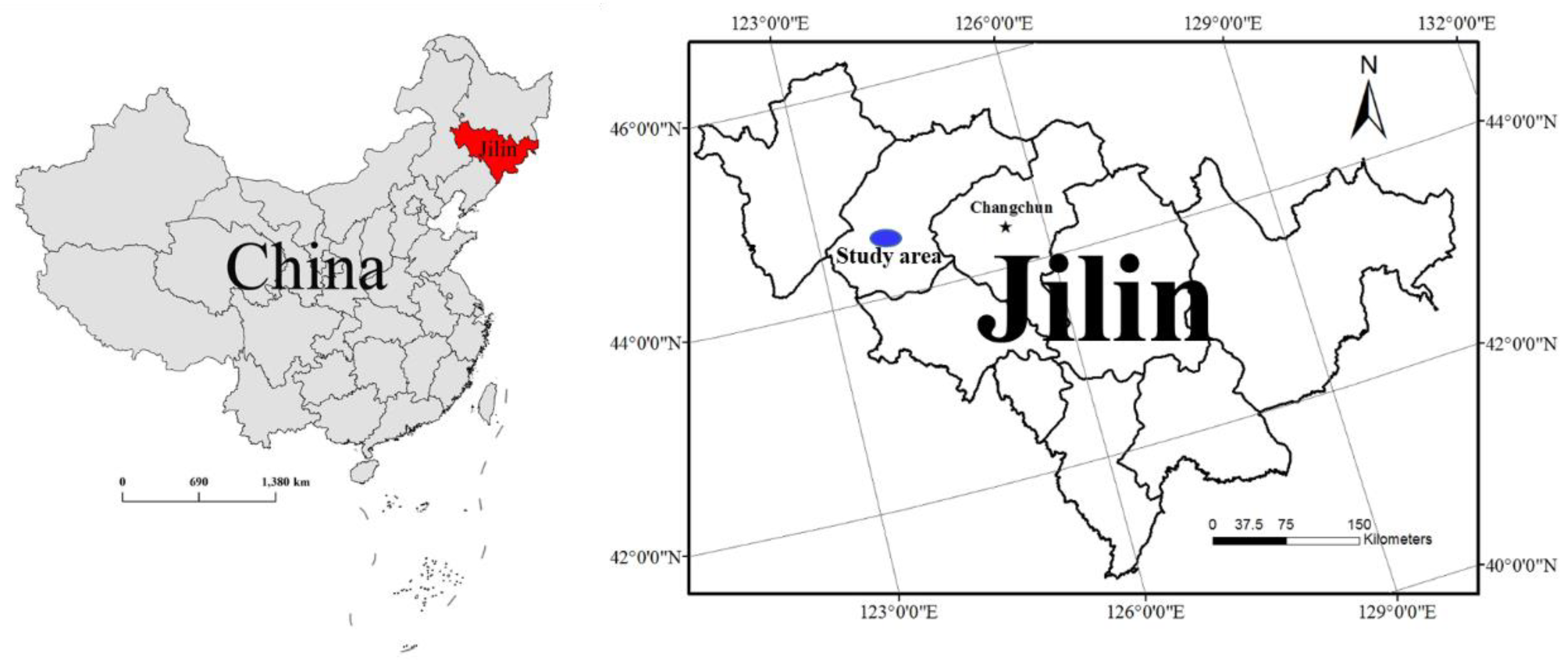

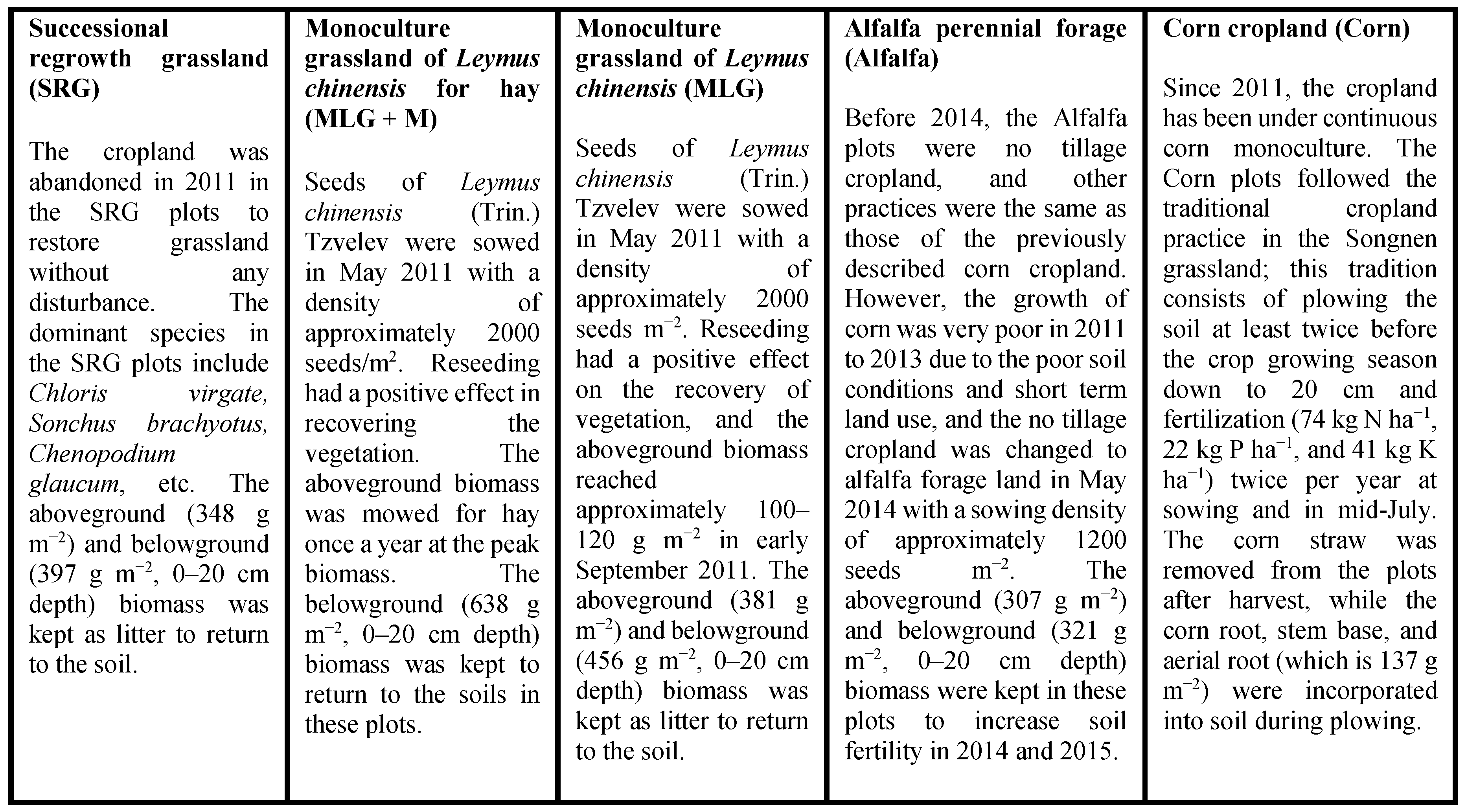
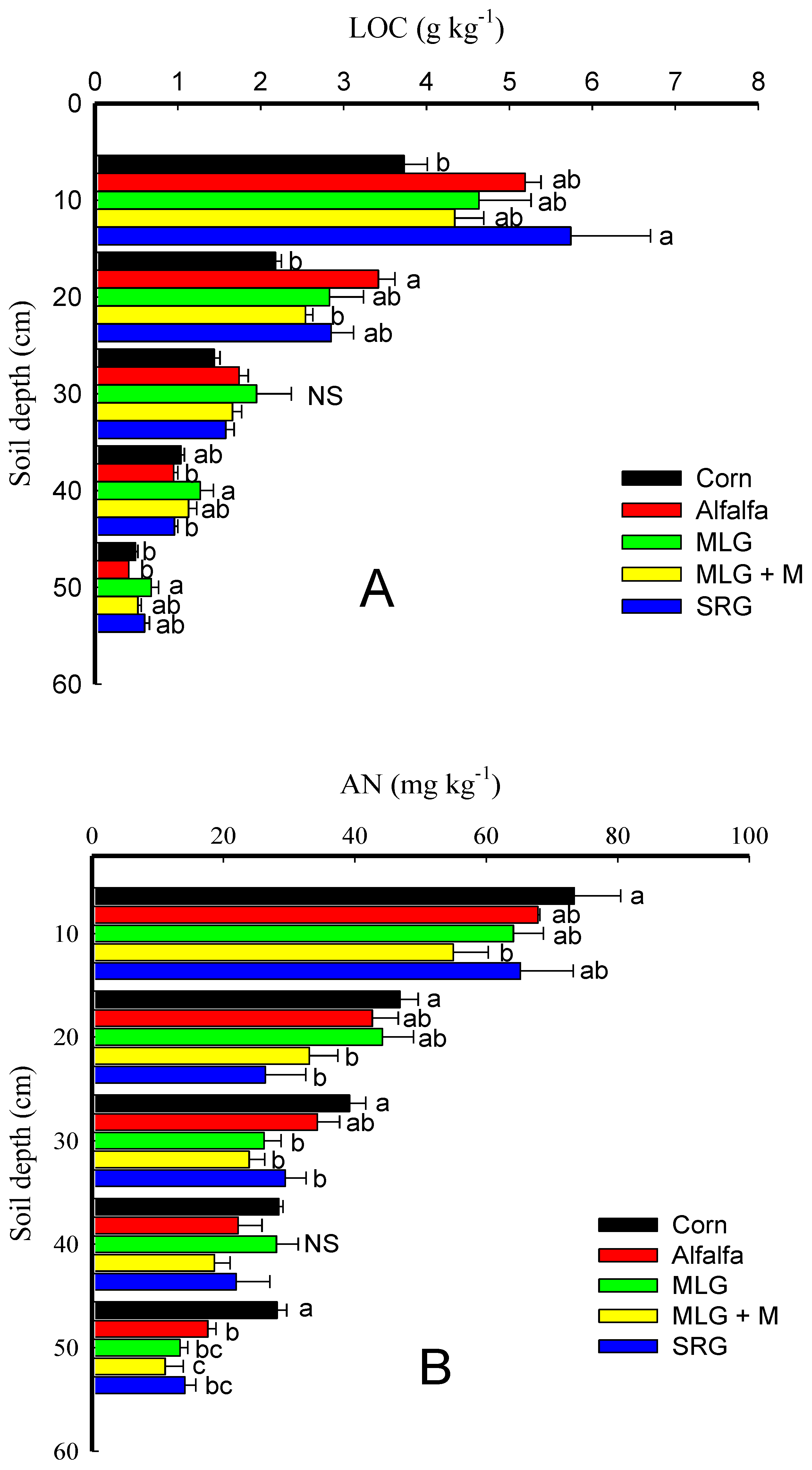
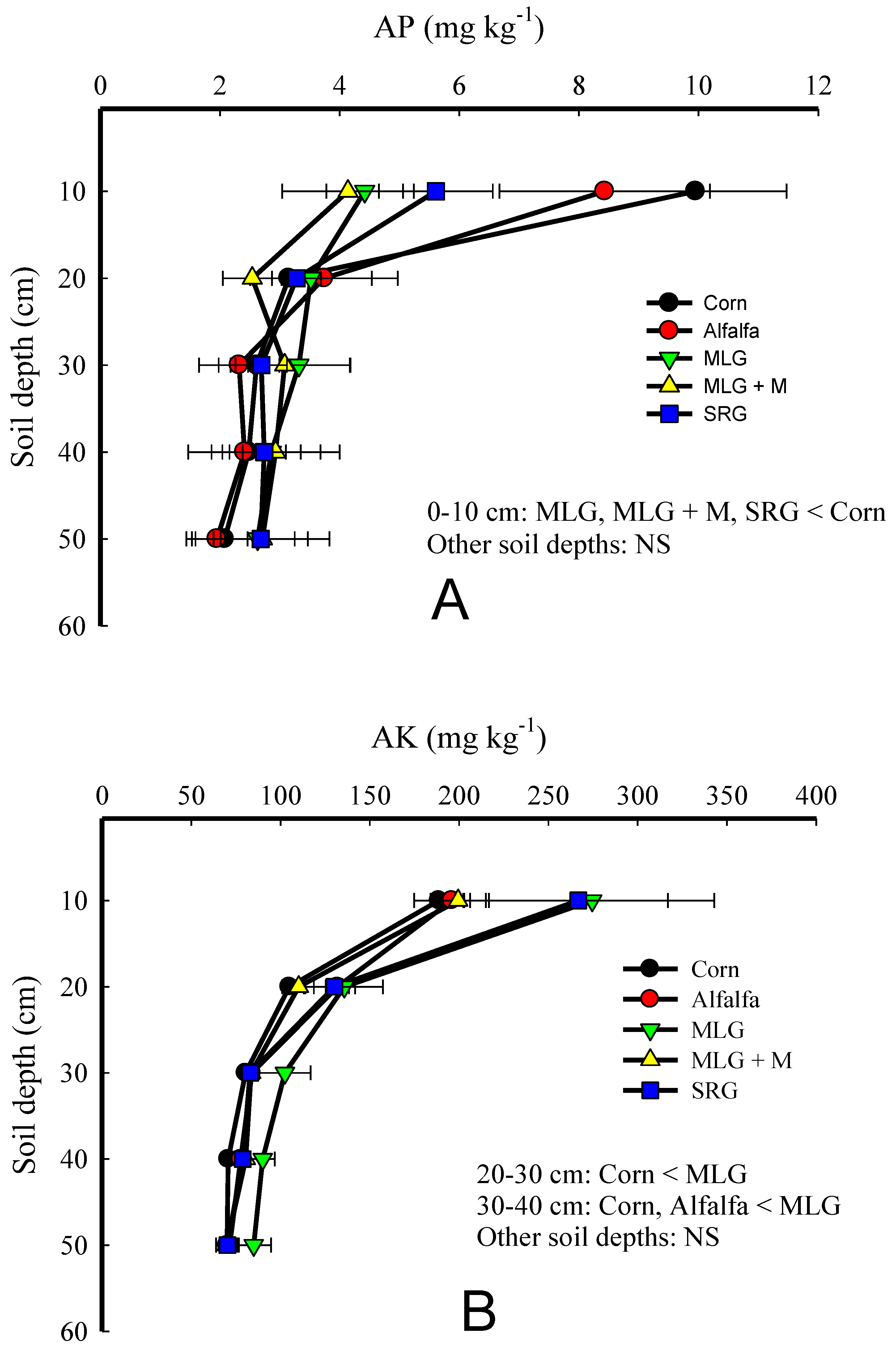
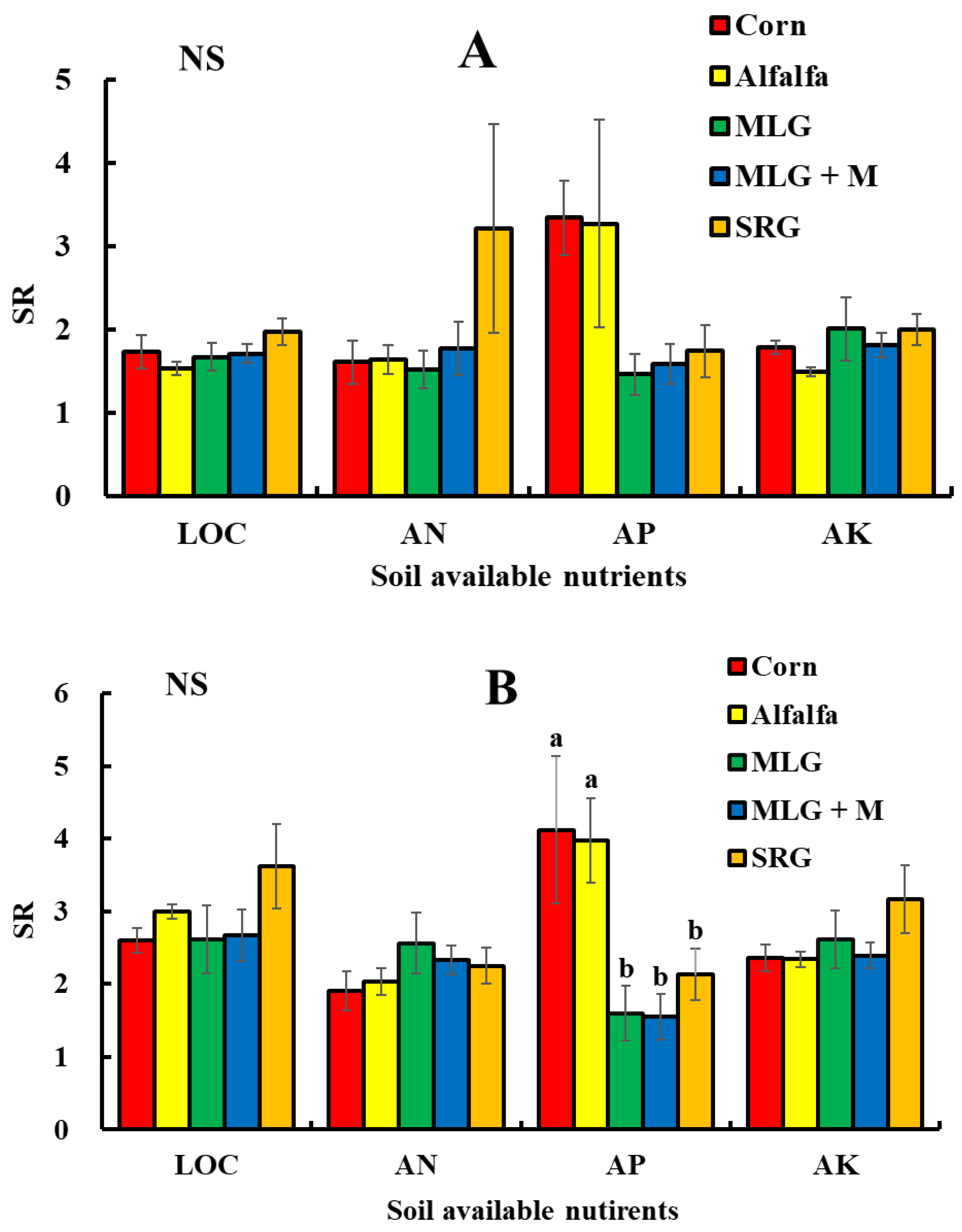
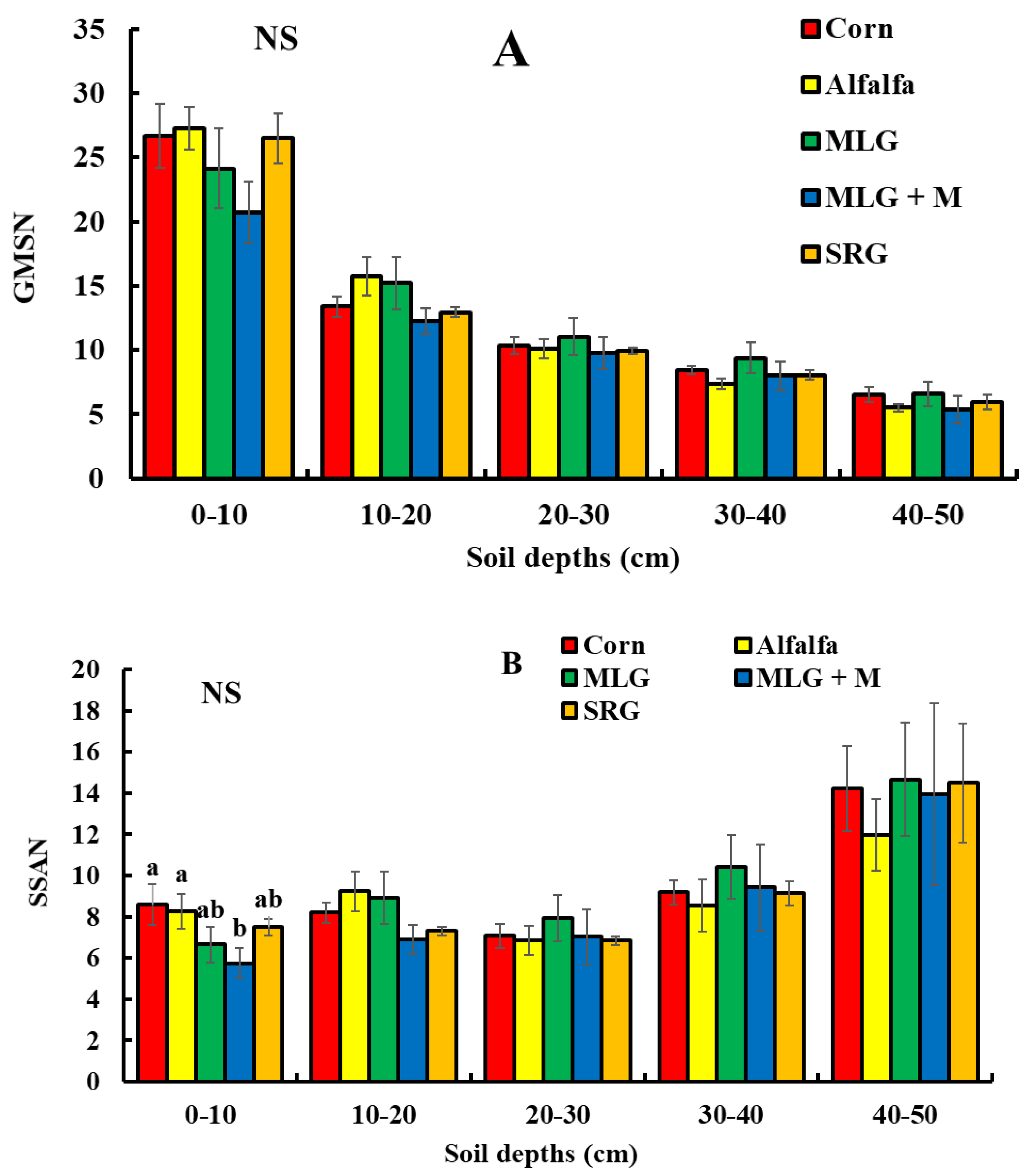
| Soil Depth | Corn | Alfalfa | MLG + M | MLG | SRG | ANOVA | |
|---|---|---|---|---|---|---|---|
| F | P | ||||||
| pH | |||||||
| 0–10 | 9.36 (±0.14) | 9.14 (±0.04) | 9.16 (±0.10) | 9.00 (±0.10) | 9.05 (±0.26) | 0.88 | 0.50 |
| 10–20 | 9.83 (±0.17) | 9.76 (±0.09) | 9.93 (±0.09) | 9.87 (±0.06) | 9.39 (±0.43) | 1.01 | 0.43 |
| 20–30 | 10.06 (±0.08) | 10.04 (±0.09) | 10.03 (±0.04) | 10.00 (±0.06) | 9.96 (±0.08) | 0.29 | 0.88 |
| 30–40 | 10.11 (±0.04) | 10.11 (±0.08) | 10.03 (±0.03) | 9.99 (±0.04) | 10.02 (±0.03) | 1.11 | 0.39 |
| 40–50 | 10.06 (±0.06) | 10.04 (±0.09) | 9.99 (±0.04) | 9.92 (±0.04) | 9.98 (±0.05) | 0.78 | 0.56 |
| EC | |||||||
| 0–10 | 204 (±16) | 155 (±11) | 162 (±5) | 157 (±21) | 164 (±24) | 1.43 | 0.27 |
| 10–20 | 330 (±56) | 306 (±43) | 398 (±53) | 376 (±32) | 335 (±101) | 0.36 | 0.84 |
| 20–30 | 391 (±49) | 385 (±65) | 531 (±55) | 491 (±39) | 435 (±95) | 1.00 | 0.44 |
| 30–40 | 389 (±31) | 391 (±58) | 576 (±46) | 501 (±55) | 492 (±75) | 2.12 | 0.13 |
| 40–50 | 350 (±17) | 349 (±59) | 481 (±56) | 468 (±64) | 452 (±45) | 1.63 | 0.22 |
© 2020 by the authors. Licensee MDPI, Basel, Switzerland. This article is an open access article distributed under the terms and conditions of the Creative Commons Attribution (CC BY) license (http://creativecommons.org/licenses/by/4.0/).
Share and Cite
Yu, P.; Tang, X.; Liu, S.; Liu, W.; Zhang, A. Short Term Effects of Revegetation on Labile Carbon and Available Nutrients of Sodic Soils in Northeast China. Land 2020, 9, 10. https://doi.org/10.3390/land9010010
Yu P, Tang X, Liu S, Liu W, Zhang A. Short Term Effects of Revegetation on Labile Carbon and Available Nutrients of Sodic Soils in Northeast China. Land. 2020; 9(1):10. https://doi.org/10.3390/land9010010
Chicago/Turabian StyleYu, Pujia, Xuguang Tang, Shiwei Liu, Wenxin Liu, and Aichun Zhang. 2020. "Short Term Effects of Revegetation on Labile Carbon and Available Nutrients of Sodic Soils in Northeast China" Land 9, no. 1: 10. https://doi.org/10.3390/land9010010





